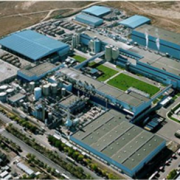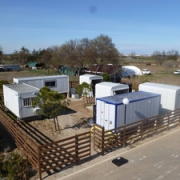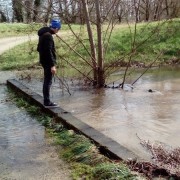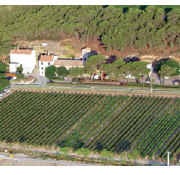Nowmma (Mauguio)
/a Toolbox /per smoreraLOCATION
Mauguio (France) 43°36’02.3″N 4°01’01.9″E
TREATMENT TECHNOLOGIES
Treatment
Post treatement desinfection
TRANSPORT AND STORAGE
Transport and storage indicators:
WWTP/WRP capacity 24.000 population equivalent
Length of the network 150 m
8 m3
Direct reuse
Domestic WW
Confidential data but between A and C quality (french regulation) according to the treatment and the storage
Grid, sieving, defating/desanding, aerated activated sludge, lagoons
No numerical data available
Chlorination, sand filtration, ultra filtration and UV
No numerical data available
Storage capacity
Pilot projet – NOWMMA Maugio (France)
NOWMMA
R&D project that aims to develop and test wastewater treatment and irrigation chains adapted to wastewater reuse (irrigation and street cleaning)
3 irrigation points
MAIN COSTS
Explain which are the main costs specific to water reuse and how is their frequency (transport, additional treatment…)
Cost of the project (until putting into operation) 2,8 M€ over 3 years
BENEFITS
Environmental benefits
Economical benefits
Identify the most cost effective wastewater reuse chains (treatment and irrigation technologies) to match water quality and uses (irrigation, regulation,…)
Social benefits
DISADVANTATGES/LIMITS
High costs of treatment for the tested desinfection solutions
Main Costs indicators:
a) Investments
Energy expenses
Consumables expenses
Maintenance expenses
b) charges
Limit the TWW disposal (before desinfection) into a pond (“Etang de l’Or”)
Waste water reuse on forestry plantation (Nègrepelisse)
/a Toolbox /per smorera| Partner: local council community Terrasses and Valleée de l’Aveyron (CCTVA)
|
||||||||||||||||||||||
| Project dates: in service since January 2014
|
||||||||||||||||||||||
| Site (region/city or town): department* of Tarn et Garonne, municipality of Nègrepelisse
|
||||||||||||||||||||||
| Scale level (national, regional, local): the area concerned by this treatment plant is the northeast of department
|
||||||||||||||||||||||
| Use/s of the reclaimed water (industrial reuse / green areas reuse/ agriculture reuse / street cleaning reuse / landscape reuse / others): agricultural end landscape reuse
|
||||||||||||||||||||||
| Short Description of the existing project:
CCTVA operates Negrepelisse sludge treatment unit. Sludge is treated by several filters. Between May and October, the treatment plant provides water to a forestry plantation. This operating increases the treatment of effluents and produce firewood for the communal heat production plant. An experimental monitoring has been initiated in 2014 for 3 years, to assess the performances of sludge treatment, tree growth and performance of the irrigation system. |
||||||||||||||||||||||
| Specificities and data (technologies, water quality, flows, etc.): 11 000 m3 of sludge could be treated on 8 filters of common reed (total surface: 2600m²). The solid part stay on the surface and the liquid phase pass through the sand layer, where is operating the microbiologic treatment. In summer time, treated waste water is stocked, then filtered, before to be reuse for watering 3,2 hectares of forestry plantation composed of poplar and eucalyptus. In 2014, 6500 m3 of sludge were treated and almost 5 500 m3 of water were reuse on plantation. | ||||||||||||||||||||||
| Is this the best application for this water? Why?
This is the best way to reuse waste water in accordance with French regulation. The reuse allows decreasing discharge impact in the river, and increasing the growth of trees which means a better way to produce energy. In the future, is there any new expected use for this water reclamation project? There isn’t other use expected because of regulation, but it should be interesting to think about cleaning street. |
||||||||||||||||||||||
| How was the project funded?
The project is born because of lack of sludge treatment plant in north east of department. This situation was source of several issues such as outlawed discharge, difficulties for monitoring sludge spreading plan, transports over long distance. Implementation costs: the cost operation is about 1,9 million euros.
|
||||||||||||||||||||||
| Legislations or other regulatory measures which affected the project:
Reuse waste water has been allowed for testing reason and only if the following conditions were respected:
|
||||||||||||||||||||||
Stakeholders
|
||||||||||||||||||||||
| Innovative aspects (existing and future)
The innovative aspect concerned :
|
||||||||||||||||||||||
| Benefits (social, environmental and economic aspects)
The social benefits haven’t been clearly identified. At the beginning, neighborhood was quiet anxious. He scared mainly of smell coming from sludge. Now, after one year operating, we have never been alerted about any smell production. The treatment plant and water reuse seem well accepted by neighborhood. We can note that the few people who know this project are quiet proud to live on a dynamic territory. The reuse avoids impact of discharge at the summer time, period where the river is the most sensitive. About economics aspects, water reuse signifies more investment (10 to 12% of total cost.) The cost of exploitation is around 5 000 euros per years and includes monitoring and energy consumption. The finality of plantation is to provide fire wood for the communal heat production plant. The production is expected between 15 and 20 tonnes dry matter/hectare after 1 years, which means the biomass production could be 1,5 to 2 higher than that is usually observed on these species without irrigation. Reuse reduces the cost of irrigation which is around 0,5 €/m3. |
||||||||||||||||||||||
| Barriers
The mains obstacles to take account are :
|
||||||||||||||||||||||
| ACTIONS TO DO IN ALERA –to be described carefully-
CCTVA will provide technical data about exploitation (problems, costs, first tendency about irrigation and treatment monitoring, etc.) CCTVA is in deal with Ecofilae to discuss about the meeting in France (date and place.) CCTVA is communicating about Alera project on his web site (site Internet) |
||||||||||||||||||||||
|
|
|
|
||||||||||||||||||||
Irrialt’eau in Gruissan (Languedoc-Roussillon)
/a Toolbox /per smorera| Partner:AQUADOC ; SCV Cave de Gruissan ; Véolia Eau ; Véolia Environnement ; Grand Narbonne ; INRA ; Unité expérimentale de Pech Rouge ; LBE Narbonne | ||||||||||||||
| Project dates:2013 to 2015 | ||||||||||||||
| Site (region/city or town):Gruissan city in Languedoc-Roussillon | ||||||||||||||
| Scale level (national, regional, local):Local level | ||||||||||||||
| Use/s of the reclaimed water:Agricultural use – Vineyards irrigation | ||||||||||||||
| Short Description of the existing project:A pilot project for domestic treated wastewater reuse is implemented in Guissan nearby the city of Narbonne. Water is used for 1.5 Ha vineyards irrigation in the experimental center of INRA.Treated wastewater comes from the Narbonne wastewater treatment plant.This project is a small-scale pilot and aims at following micro-pollutants contents in grapes and wine.
If results are encouraging, more wine-growers are interested in reusing treated wastewater. |
||||||||||||||
| Specificities and data (technologies, water quality, flows, etc.):Water treatmentWater quality B (French regulation) : pre-filtration + UV and chlorination (slight)Water quality C (French regulation) : pre-filtration + chlorination | ||||||||||||||
| Is this the best application for this water? Why?Water is rejected into the sea if not reuseIn the future, is there any new expected use for this water reclamation project?More farmers may join the project in the future as there is enough water for 50 Ha of vineyards. | ||||||||||||||
| How was the project funded?Languedoc Roussillon region funded part of the project | ||||||||||||||
| Legislations or other regulatory measures which affected the project:The project had to comply with the specific French regulation (in 2010 the 2nd of august revised in 2014 the 25th of june) on wastewater reuse for irrigation purposes.This regulation sets standards for water quality. | ||||||||||||||
Stakeholders
|
||||||||||||||
| Innovative aspects (existing and future)First project of wastewater reuse for vineyards irrigation in FranceFirst wastewater reuse project to follow micro pollutants
|
||||||||||||||
| Benefits (social, environmental and economic aspects)Improve technics and risks mitigation methods for wastewater reuseEncourage social acceptance of wastewater reuse
Improving vineyards yields through irrigation in a water scarce area |
||||||||||||||
| Barriers Limited social acceptance for wine consumersEconomic profitability of the project at large scale needs to be demonstrated
|
Etiquetes
Pàgines
- Contacte
- Documentació
- Documents toolbox
- Equip
- Fotografies Es Migjorn Gran
- Fotografies Granollers
- Fotografies Montpellier
- Granollers
- Informació pràctica
- Inici
- Inici en directe
- Inscripcions
- Inscripcions a les Labs
- Nous models
- Ponents
- Programa Es Migjorn Gran
- Programa Granollers
- Programa Montpellier
- Programa Nègrepelisse
- Projectes de ciutat
- Què és?
- Recull de premsa
- Sample Page
- Socis
- Streaming
- Toolbox
- Vídeos
- Vídeos toolbox




